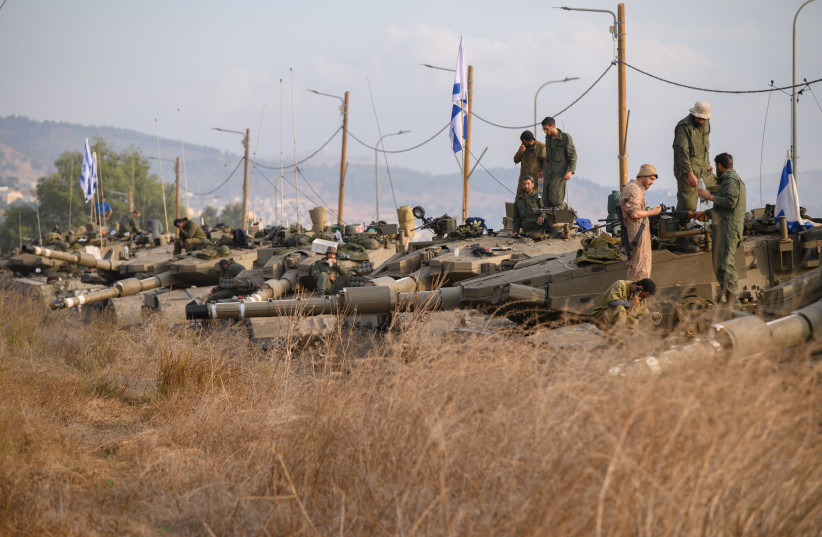Threats to northern Israel are increasing on a daily basis as there are small clashes. These clashes are always initiated by Iranian-backed groups in Lebanon and Syria and Israel is forced to respond. This comes in the context of Hamas feeling confident after a meeting with Iran’s Foreign Minister in Qatar.
Hamas leader Ismail Haniyeh met with Iran's foreign minister on Saturday in Qatar, where they discussed the Palestinian militant group's deadly attack in Israel "and agreed to continue cooperation" to achieve the group's goals, Hamas said in a statement, according to Reuters. Qatar has hosted Hamas for many years. Hamas carried out a massacre of Israeli civilians on October 7, and has kidnapped 200 people.
In recent days the threat to Israel’s north has appeared to be like a drumbeat of war clouds. This is because since the October 7 attack from Gaza there have been numerous incidents along the border. It’s worth looking at these incidents and how they developed. Hezbollah has claimed at least seven of these “operations” as attacks. This shows Hezbollah is not deterred and is choosing when and where to attack.
The tensions have been rising since last year when Israel and Lebanon signed a US-backed gas deal. From that moment, when Hezbollah threatened war if Israel didn’t sign the deal, the Iran-backed groups have increased threats from Lebanon. In the old days, after 2006, it was uncommon for there to be any incidents along the border. Hezbollah was considered to be deterred. However in recent years that equation seems to have changed. For instance Hezbollah and Iran have worked increasingly with Hamas and other groups to create threats. This included rocket fire this year during Passover. It also meant Hezbollah set up a tent in a disputed area.
Now this has gotten worse and escalated. On October 7 after the Hamas attack tensions grew. On Monday, October 9, there were exchanges of fire and mortar shells fired at Israel. A number of suspects tried to infiltrate the border. This was followed on Tuesday by anti-tank fire at Avivim in which one IDF soldier was killed. 15 rockets were launched at Israel. On Wednesday there were more suspected infiltrations and then more alerts in the north and anti-tank fire near the border community of Arab al-Aramshe. Israel has numerous communities along the border and now the people must run for shelter when there are alerts. It appears Hamas has also tried to threaten Haifa and the north with rockets. On Friday there was also an unidentified object detected over Misgav Am on the border. There was an alter in Hanita as well.

IDF intercepts objects over Haifa, strikes Hezbollah targets
On October 14 the IDF noted that “following the reports on the sound of explosions over the city of Haifa, the IDF Aerial Defense Array intercepted two unidentified targets above the city of Haifa. No sirens were activated according to protocol.” Another unidentified object was detected over Shfar’amr, a city near Haifa. The IDF intercepted it. The IDF has struck Hezbollah terror targets in Lebanon in response to these infiltrations. For instance “IDF soldiers identified a terrorist cell which attempted to infiltrate from Lebanon into Israeli territory. An IDF UAV targeted the terrorist cell and killed a number of the terrorists,” the IDF said.
There have been threats to Har Dov, a disputed area near Metulla. And there have been threats from Syria. These have included rockets fired from Syria that caused alerts near Avnei Eitan in the Golan. The IDF also said over the weekend that “following the initial report regarding sirens sounded in the community of Sdeh Eliezer, an interceptor was launched toward a suspicious target, and the interceptor activated the sirens. The incident is under review.”
On Sunday there were more attacks. An anti-tank missile, the third incident of this kind, was fired near Shtula on the border. The IDF used artillery in response. The IDF is now warning communities within four kilometers of the border about these threats. However it is clear that the attacks are testing Israel and feel some kind of impunity. So far the response has been proportional. The threat nevertheless continues and the attackers choose when and where to attack. The Iran-Hamas meeting in Qatar illustrates that both are coordinating the next moves to threaten Israel.
